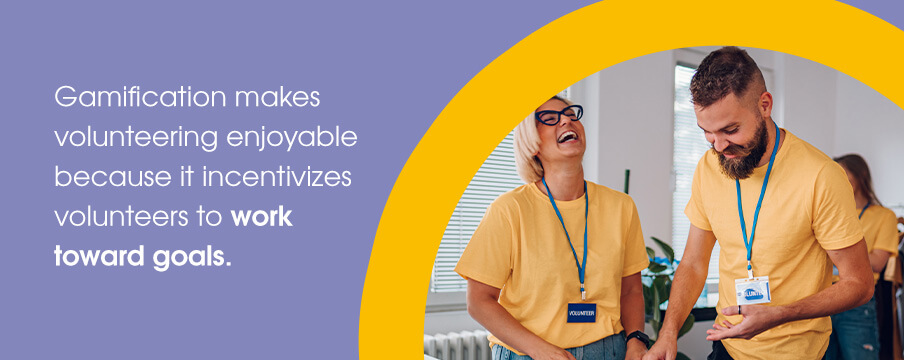If your organization is fortunate enough to have people donating their time to you, you probably know the basics of how to support your volunteers — including sending information packets to new recruits, holding orientation and training sessions, creating a volunteer handbook with your policies and protocols, and thanking them frequently.
But how can you keep your volunteers engaged and excited about working with you? Gamification strategies offer an ideal solution. Gamification involves systems that reward volunteers’ efforts, special achievements, and dedication to your organization. In this guide, we’ll review what gamification is, why it’s effective, and how you can apply it to your volunteer efforts.
What Is Gamification?
Gamification is the practice of using game-design elements in non-game scenarios. Specifically, it uses reward-based incentives to motivate workers or volunteers to have fun completing tasks — these include leaderboards, rewards, points, and badges, among other incentives.
Gamification plays into certain deeply-rooted elements of human psychology. Including game elements like stakes and rewards, competition, achievements, and imaginative problem-solving often triggers the release of dopamine, the “happy” chemical in our brain. We tend to feel more engaged and fulfilled participating in activities that offer periodic incentives or rewards, as they keep us focused on the goal — this is referred to as extrinsic motivation.
Businesses increasingly use gamification to motivate employees by making their workday tasks more fulfilling. For instance, employees might work through the levels of a game-oriented virtual training program and receive prizes for each one completed. Or they might receive rewards for every milestone met on company Fitbits or other wellness challenges.
Why You Should Use Gamification for Volunteers
There are several aspects of gamification that make it an effective tool. Here are a few of the reasons you should use gamification with your volunteer program:
- Makes work and training fun: Gamification can make your volunteers more engaged when learning new things. Training can sometimes feel daunting to new volunteers, and the work can be tedious and mundane. Gamification can help them have fun, relax, and get excited about all there is to learn. Introducing positive game elements to the day makes the time pass more quickly and helps volunteers have fun working.
- Provides incentives: Gamification makes volunteering enjoyable because it incentivizes volunteers to work toward goals. While volunteers are often intrinsically motivated to help an organization they care about, an extra incentive can make the process more enjoyable and boost their motivation.

- Gives meaning to tasks: Doing the same few tasks every week can sometimes become rote, even for motivated volunteers. Gamification provides an incentive structure that helps give meaning and purpose to routine labor.
- Offers volunteers more control:With gamification, volunteers can choose how fast they progress through the game and control their achievement levels. Giving volunteers ownership over their goals and accomplishments can help them feel more motivated because they’ll be able to choose rewards they actively want to obtain.
- Taps into natural competitiveness: Competition in volunteering can be an asset when wielded effectively. When people compete for fun prizes or merely bragging rights, they’ll have a little extra fire and determination as they work — whether they’re seeing how many quizzes they can take to boost their knowledge or who can find the treasures hidden in often-missed cleaning spots. Volunteering competitions in a friendly, low-stakes environment will likely remain good-natured and enjoyable and boost productivity.
- Communicates your thanks: Your volunteers work hard and deserve thanks. Using gamification strategies to give your volunteers small, frequent rewards can be a way of saying thank you to your volunteers for all they do — though you’ll probably want to say thanks directly as well!
Benefits of Investing in Gamification in Your Volunteer Organization
Below are a few of the advantages of incorporating games and incentives into your volunteer program:
1. Quantifying Objectives and Achievements
One main benefit of gamification is that it helps define measurable objectives and goals. For example, you might develop a game at your animal shelter to track the steps or miles of the volunteer dog walkers. They can earn points and prizes for every mile of dog walking they do, and you can offer prizes for the top walkers or when volunteers pass certain benchmarks. This system is a quantifiable way to reward loyalty, commitment, and hard work. With Volgistics, you can track up to 120 different one-time awards and use Sets for repeating rewards.
2. Boosting Engagement, Motivation, and Productivity
Even though most volunteers choose to give their time because they care, a little external motivation can do wonders for their enthusiasm and productivity. In 2023, Gallup found that only 33% of workers were truly engaged in their work. Gamification applications for nonprofits are particularly crucial because resources are often thin, and every bit of extra engagement and productivity can be vital to the mission’s success.
3. Enhancing Knowledge Retention
When people engage in a fun, challenge-based learning activity, they are likely to retain the information longer — this impact is enhanced for introverted individuals who may not engage as much with other activities. Active engagement can cement the material in their minds and help them recall it better later.
4. Providing Clear Progress Markers
Gamification also tells your volunteers exactly how far they’ve come and how far they have left to go. If you quantify volunteers’ progress — say by setting up a digital game that allows them to collect virtual ranger badges as they work through learning tiers about environmental practices — they’ll have a practical system for assessing their learning progress and a clear map for where they’re headed.
5. Recognizing Hard Work
How do you recognize your volunteers? Volunteers don’t always get the recognition they deserve, and gamification is an easy way to change that. Giving out small prizes for achievements in tasks you create helps you perform more consistent volunteer recognition and fosters an atmosphere of celebrating success.
6. Making Volunteers Feel Valued
How do volunteers feel valued? Often, it’s when you show your appreciation. When you give volunteers small, frequent rewards, you do more than merely give them prizes. You also make them feel like valued, necessary parts of your organization. The incentives you create for rewarding volunteers don’t have to be big ones — small, heartfelt rewards can go a long way toward making volunteers feel seen and appreciated.
7. Boosting Volunteer Recruitment and Retention
Happier, more fulfilled volunteers are likely to stay with your organization longer. Once the word gets around in your community about how fun and engaging your volunteer program is, you may experience a noticeable uptick in applications.
What Would Gamification Look Like in a Volunteer Setting?
How do you use gamification? In a volunteer setting, gamification might take many forms depending on your needs and the composition of your group. Below are a few different options for how to use volunteer gamification in your organization:
Creating Knowledge- or Skill-Building Games
To make sure your volunteers are familiar with your organization and its policies and procedures, consider using games to help volunteers test and build knowledge. For instance, you might sit down with a small group of volunteers and host a Jeopardy-style game with questions written on pieces of paper and sorted into different categories.
To reward everyone’s learning, you might give a larger prize — like a full-sized candy bar — to the winner and smaller prizes, like smaller candies, to everyone who accrued points. You can also test skills this way by giving rewards for writing, plant identification, or knowledge of a tricky phone system — the list is endless.
Developing a Volunteer Incentive Program Point System
You might also give each task a specific point value and let volunteers earn points as they complete activities. Participating in an hour’s worth of fundraising for a performing arts venue might be worth 30 points, or cleaning one room at a hospital might be worth 50.
Once the volunteers earn a specified number of points, they can cash them in for small rewards, or the whole group could earn points toward a pizza or sundae party. You might even develop a digital system to keep track of the points.
Incentivizing Attendance
Most organizations get more out of their volunteers if the volunteers show up regularly. To encourage regular participation, you could keep track of how many weeks in a row people come in to volunteer. A streak of five weeks might merit a small prize or badge, whereas a streak of 50 weeks — almost a whole year — might merit a much more substantial one. You’ll likely see better attendance, and volunteers will feel recognized for their commitment, loyalty, and hard work.
Promoting Team Unity
How do you build relationships with volunteers? One way is to create good-spirited team competitions. If your organization decides to include team elements, gamification can become a way to foster camaraderie. As your team members celebrate achievements together, they’ll become closer and more invested in one another’s successes.
Developing Fun Themes
One way to engage volunteers is to incorporate fun topics as themes of your gamification structure. If you know your volunteer team loves Harry Potter, for example, you could design an activity where achieving different tiers in the game would unlock various elements of the Harry Potter universe.
At tier one, your volunteers might earn the reward of being sorted into houses — for an animal shelter this could mean animal-themed houses like the Ravencats, Gryffindogs, Hufflepaws and, well, Slytherin. Volunteers could have their names affixed in decorative house badges on the wall. At tier two, volunteers might gain Patronus stickers to display on their nametags — or whatever you think your volunteers would enjoy and want to work toward.
Creating a Visible Leaderboard
A volunteer leaderboard can be a fun way to spur friendly competition among your volunteers. Update volunteer point totals frequently and make some low-key festive fanfare when someone new reaches the board. Be careful not to demoralize lower-performing volunteers, though — if you can, set up your scoring so everyone can remain competitive if they put in a sincere effort.
Gamification for Volunteers — Challenges and Best Practices
When you’re thinking about introducing gamification into your volunteer program, it’s important to do so carefully. There are some potential downsides of gamification, which require a nuanced approach.
- Authenticity: One danger of gamifying your volunteer opportunities is that you risk attracting individuals who might only be in it for the rewards. Your organization needs dedicated volunteers who are authentically interested in your mission and goals.
- Engagement: Gamification may also come with the challenge of volunteers eventually getting bored or frustrated. If people don’t feel like they are “progressing” in the system, they might disengage and eventually stop volunteering altogether.
- Negativity: While competition is a great motivator, it also comes with some potential negative side effects. Gamification can become toxic if it introduces too much competition or pits volunteers against each other. After all, the purpose of volunteer work is to work together toward a goal.
- Ethics: While certain volunteer activities, like working at a 5K run or spending time with animals at a shelter, can be fun and easy to gamify, other roles may not be. It might not be fair to the beneficiaries of your organization to gamify volunteer activities if it doesn’t match the tone and purpose of your mission.
- Availability: Your organization likely relies on a host of volunteers with varying degrees of availability. Some may be able to volunteer a few days a week, while others can only manage a few days a month. It may be difficult to ensure fairness with rewards based on participation.
To avoid these challenges, consider how you can apply some of these volunteer gamification best practices:
1. Make It a Low-Risk and High-Reward Endeavor
Volunteers come to your organization to help you and feel good about themselves. So you want to give them a game structure that encourages them in their efforts and rewards even small triumphs. If your game is too daunting, volunteers may feel reluctant — they might even stop coming because they want to avoid the pressure to compete.
If you play a Jeopardy game, don’t use it to quiz volunteers on obscure facts — use it to make sure they have the fundamentals of essential procedures down. Making it hard for your volunteers to fail and easy for them to succeed can help your gamification strategies thrive.
3. Play to Your Team’s Interests
If you know your volunteers well and have learned some of their interests — including books, sports, TV shows, music, hobbies — incorporating them into your volunteering incentives can be an excellent strategy. For example, you might host an appreciation party for volunteers and let the person with the most hours choose the movie everyone watches.
4. Offer Your Group Options
Sometimes, implementing “mandatory fun” at work to boost morale can have the opposite effect. Not everyone enjoys sports or boisterous competition, and introverted or less physically inclined volunteers could easily feel intimidated or left out. To increase the likelihood of providing a positive experience, try to allow volunteers to choose the reward-based activities they want to participate in.
5. Give Meaningful Rewards
Spend some time thinking about how to reward volunteers in a way they find meaningful. The rewards you give don’t have to be expensive or flashy — treats like an ice cream day or small gift cards to favorite local eateries are often appreciated. It’s simply best when you can make them meaningful for volunteers. Along with their prizes, you might give volunteers heartfelt notes of appreciation, or create coveted badges volunteers can earn as a testament to the meaningful skills they’ve acquired.
6. Incorporate Your Existing Tools and Software
To make the process easier for yourself, see if you can leverage your existing tools as part of your gamification architecture. If your volunteer management platform allows for it, use the messaging system as part of your volunteer recognition service. This may include sending fun texts or emails to your volunteers when they’ve won prizes or leveled up.
Contact Volgistics for All Your Volunteer Management Needs

Now that we’ve explored gamification and volunteerism, you know games and rewards can be vital for engaging your volunteers, making their work more lighthearted, and showing how much you value their growth. It also helps you boost volunteer recognition and retention over time.
You’ll need a way to manage all the volunteers your organization retains with its new gamification techniques. To see the benefits of a versatile volunteer management platform, partner with Volgistics. The Volgistics platform is a powerful, feature-rich, and scalable program. It will grow with you and allow you to recruit, track, message, and generate reports for your volunteers, whether you have a dedicated five or 5,000. You can even sign up for a free 30-day trial so you’ll know what you’re getting before you commit.
Contact us today to learn more.

